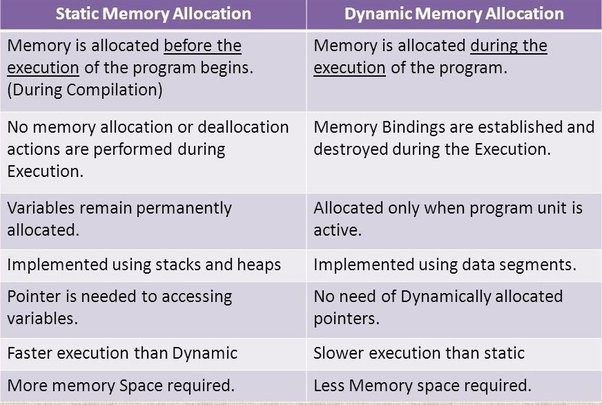
Static and Dynamic Memory Allocation in C
Static and dynamic memory allocation are two distinct approaches to managing memory in C programming. Here's a detailed explanation of the differences between them:
1. Definition:
Static Memory Allocation: Memory is allocated at compile time. The size and location of memory are determined before the program starts running.
Dynamic Memory Allocation: Memory is allocated at runtime, i.e., while the program is executing. The size and location of memory can be determined during program execution.
2. Lifetime:
Static Memory Allocation: The allocated memory exists for the entire duration of the program. It is fixed and cannot be changed during program execution.
Dynamic Memory Allocation: The allocated memory can be created and released (freed) during program execution. It can have a variable and shorter lifetime.
3. Storage Location:
Static Memory Allocation: Memory is typically stored in the program's data section (global variables) or on the stack (local variables).
Dynamic Memory Allocation: Memory is usually stored on the heap, a separate region of memory from the program's stack and data sections.
4. Size Determination:
Static Memory Allocation: The size of memory must be known at compile time and cannot be changed during runtime.
Dynamic Memory Allocation: The size of memory can be determined and adjusted dynamically during program execution using functions like malloc, calloc, and realloc.
5. Allocation Method:
Static Memory Allocation: Variables are declared with a fixed size, and memory is allocated automatically.
Dynamic Memory Allocation: Functions like malloc, calloc, and realloc are used to explicitly allocate memory dynamically.
领英推荐
6. Accessing Variables:
Static Memory Allocation: Variables are directly accessible using their names.
Dynamic Memory Allocation: Dynamically allocated memory is accessed using pointers.
7. Memory Management:
Static Memory Allocation: Memory management is handled by the compiler and the program's execution environment.
Dynamic Memory Allocation: Memory management requires explicit action by the programmer, including deallocation (freeing) of memory using the free function.
8. Error Potential:
Static Memory Allocation: Less prone to memory-related errors like memory leaks or buffer overflows.
Dynamic Memory Allocation: More prone to errors if not properly managed, leading to issues like memory leaks or segmentation faults.
9. Usage Examples:
Static Memory Allocation: Typically used for arrays with a fixed size, global variables, and constants.
Dynamic Memory Allocation: Used for data structures whose size depends on user input, resizable data containers, and scenarios where flexibility in memory allocation is required.
10. Efficiency:
Static Memory Allocation: Generally more efficient in terms of memory usage and access speed for small, fixed-size data.
Dynamic Memory Allocation: Provides flexibility for managing memory efficiently for variable-size data structures but may have slightly slower access times due to heap allocation.
The choice between static and dynamic memory allocation depends on the specific requirements of a program. Static allocation is suitable when the size of data is known in advance and when efficiency and predictability are important. Dynamic allocation is preferred when the size of data can change at runtime or when memory needs to be managed dynamically.
Undergrad in Computer science and Business systems
7 个月Pointer is not needed to access the variables in Static memory allocation.Correct that mistake .if I'm wrong let me know sir Uttam Basu
Frontend React Developer | DSA | JavaScript, React.js, Git & GitHub, SQL, HTML and CSS| CSE-AIML'26 | Content Creator
8 个月helpful content ??